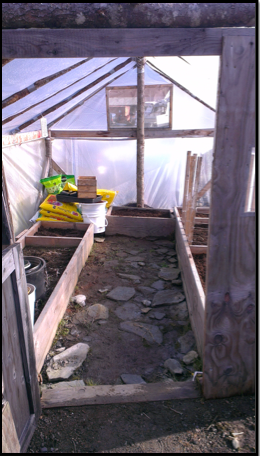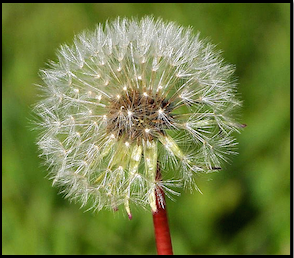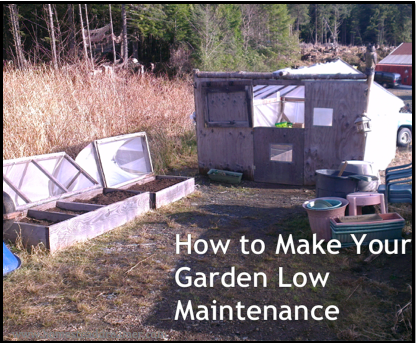I often get asked how much time and energy it takes to have my garden. Most are surprised when I tell them that my busiest times are at the beginning and end of the growing season but there isn’t much in between. That’s not to say that I don’t go out there every.single.day because I do! I love looking at what is growing and can troubleshoot any issues before they turn into problems. Overall though, my garden is extremely low maintenance.
First, we will look at what kind of maintenance a garden requires. No matter if you have a 200 square foot space to grow food in or an acre, the maintenance is basically the same. We will then cover both the store bought and DIY methods you can implement to decrease the work for you while still getting the results you want out of the garden.
What Maintenance Does a Garden Need?
Soil – If you are like me, you let your garden soil rest through the winter. All of the nutrients soaked up by the plants need to be replaced! Organic material needs to be added, fertilizer, etc. You may find that your soil needs to be amended in other ways, too.
Watering – Self explanatory though if you have a green house or covered cold frames like we do, there is a little more involved than just letting the rain handle it for you.
Seeding – Seeding your garden can be tedious work to say the least!
Weeding and Thinning – It is important to week and I don’t know a single person who actually enjoys it. Thinning out the seedlings is also another tedious pain in the backside (sometimes literally!) and I personally dislike doing it. Every little carrot sprout I have to tear out of the ground breaks my heart: I am throwing away food!
Harvesting – NOT harvesting can lead to fungus issues, not to mention attract pests and generally makes the area stink with rotting vegetation. I learned the first year that you really do need to make sure you remove all of the plants and get the roots out of the soil. If you don’t you could end up like me and have to sit for hours, hand tilling the soil, to break up the root wads.
Store-Bought Solutions
You can buy everything you need to make your garden require less maintenance. Getting new soil and fertilizer each year is an option (but you would still have to dig out the used soil and till it up).
For watering purposes, you can buy soaker hoses, connectors, and stakes. Simply turn the knob and water flows into the beds and rows, leaving you free to do whatever you want.
When it comes to weeding, you can buy garden fabric that will not keep all weeds from growing but it certainly helps! There is an added advantage of the fabric keeping the soil warmer, too.
Traditionally, people would just use their hands to sow seeds and then come back later and thin out the rows of sprouts. There are seed sowers that can reduce the amount of thinning you may have to do and help you cut down on how many seeds you are using each year. Of course, you could buy seed tapes that already have the seeds in place. Simply place, cover with dirt, water a little and you’re done. The downside to it is what kind of vegetable variety you end up with. It may or may not be a good match for what USDA Zone you are in.
There are all sorts of harvesting equipment out there that can make things go more quickly. There are ones that fit on your fingers for one-handed snip harvesting as well as various grabbers and wire sifters available.
DIY Solutions
I should point out that this article is geared toward the backyard farmer or hobby farmer, not a commercial set up. This is also assuming you are growing food versus flowers. Taking that into consideration, the following DIY suggestions may or may not work for your set up. That being said, part of being a DIY’r is figuring out ways to make things work!
 Buying new soil every year is not something most people can afford. Let’s face it, most people garden to help cut down on their food bill, regain control over their food source, or want food that is truly organic and chemical free. That means you need to put those nutrients, minerals, and organic material back into it so it is ready for the next year. Here are some solutions:
Buying new soil every year is not something most people can afford. Let’s face it, most people garden to help cut down on their food bill, regain control over their food source, or want food that is truly organic and chemical free. That means you need to put those nutrients, minerals, and organic material back into it so it is ready for the next year. Here are some solutions:
- Find a friend who composts and see if you can get some of it (barter for work or something?).
- People who raise rabbits generally have far more manure than they need and rabbit poo is perfect for putting directly in the garden.
- For those that live on the coast, seaweed is another fantastic (and free) way to get some minerals and minor organic material back into the soil.
Watering using soaker hoses can be done with ease…and cheap! You can get some old garden hose and punch holes in yourself. For the actual water, grab a 5 gallon food grade bucket. Cut a hole in the bottom big enough for the hose or attach a spigot that the hose will screw on to. Elevate the bucket at the edge of your row, bed, or cold frame so gravity will do the work for you. Simply fill the bucket and let the water drain out into the garden during the dry times. This can also work very well inside greenhouses, too! If you do a water catch system, you can make things even easier!
There really is no need to buy seed tapes, pre-seeded or not. You already have all you need! Using either toilet paper or newspaper, you can easily make your own for seeding the garden. This practice will help you save time (lack of thinning) and money (less seeds used). It also makes it very easy to spot where the sprouts didn’t take hold and you can sow by hand in those areas.
When it comes to those pesky weeds, I have seen some crazy stuff being done. Instead of buying garden fabric, you can use old t shirts, blankets, etc. Keep in mind that if you go this route that any residue from laundry detergent, softener, and dryer sheets can leech into the soil. Boiling the cloth first will help remove the chemicals. You can also get in contact with a local hay or straw farmer and see about a trade.
Another wonderful, often overlooked option is wood chips. Contact tree removal companies: chances are very high that you can get all the wood chips you could ever want for free. Some will even load the truck for you or charge a nominal fee for the convenience. Still others will deliver it right to your property! Trust me, they want to get rid of it so they don’t have to pay for storage or removal themselves.
 One more note on weeding: I truly have minimal weeds to pull. The reason for that is, if you look at the title picture, you will see that everything of mine can be covered. We close everything up at night and open them during the day. It keeps a lot of slugs out and there is less chance for weed seeds to get blown in. My average weeding time is about 5-7 minutes. Growing in containers also results in less weeds to be dealt with. Even if you are on a serious budget and have limited space, you can still garden!
One more note on weeding: I truly have minimal weeds to pull. The reason for that is, if you look at the title picture, you will see that everything of mine can be covered. We close everything up at night and open them during the day. It keeps a lot of slugs out and there is less chance for weed seeds to get blown in. My average weeding time is about 5-7 minutes. Growing in containers also results in less weeds to be dealt with. Even if you are on a serious budget and have limited space, you can still garden!
Harvesting is the best part of the whole thing, right? Getting all of the delicious goodies out of the Earth brings joy and rumbly tummies. The trouble is, it can really break your back being bent over for an hour, cutting green beans and pea pods off the plant. For things that are being harvested multiple times throughout the growing season, get a bucket to sit on. Seems like a no brainer, right? It makes a huge difference. It also helps you to see more of what is ready for picking. For the other things that are being harvested once, pull the whole plant.
I’m not kidding, the whole thing. Let’s say it is the final harvest of the garden. Yanking the entire plant up instead of harvesting off it and then pulling up the leftovers makes more work for yourself. Imagine how much easier it is to get all the green beans off the plant when you just have the whole thing? I did it last year and swore I would do it that way forever. Pull the whole thing, toss it onto a makeshift table in the garden and go to town. The leftovers are composted or saved and given to people who have chickens (and we get eggs!).
I know many of you have other ideas on ways to minimize the time and effort needed in your gardens and I want to hear about it! Give us a comment below. Your suggestion may help people do more with less or even get someone started!




